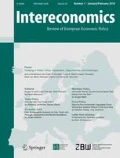Abstract
Unlike other transition economies the People's Republic of China has so far not only avoided a severe transition crisis; it has apparently also managed to make economic transition a source of growth. However, the country now faces a number of crucial transition problems that centre around the debt situation of state-owned enterprises and the fragile condition of the financial system. Could these problems, for which solutions have repeatedly been postponed, trigger a late transition crisis?
We’re sorry, something doesn't seem to be working properly.
Please try refreshing the page. If that doesn't work, please contact support so we can address the problem.
References
World Bank: The East Asian Miracle, Economic Growth and Public Policy, Washington, D.C. 1993.
N. Schlotthauer: Will the People's Republic of China Trigger Off the Next Asian Crisis? in: INTERECONOMICS, Vol. 34 (1999), No. 3, pp. 124–135; P. Rieger: China im Sog der Asienkrise, in: Wirtschaft und Gesellschaft, Vol. 4 (1998), pp. 559–565; F. J. Gurtner: The Stability of the Renminbi in the Wake of the Asian Financial Crisis, in: INTERECONOMICS, Vol. 34 (1999), No. 3, pp. 135–143.
(World Bank: China 2020: Development Challenges in the New Century, Washington, D.C. 1997, p. 3).
(World Bank: The Chinese Economy. Fighting Inflation, Deepening Reforms, Washington, D.C. 1996, p. 5).
World Bank: The Chinese Economy…, op. cit. Fighting Inflation, Deepening Reforms, Washington, D.C. 1996, p. 5.; Bundesstelle für Außenhandelsinformation: Wirtschaftsdaten Aktuell, VR China, 23 June, 1999.
H. Herr, S. Tober: Unterschiedliche Marktkonstellationen. Was unterscheidet die Entwicklung in der VR China von den Ländern der ehemaligen Sowjetunion und den Visegradstaaten?, in: H. Herr, K. Hübner (eds.): Der lange Marsch in die Marktwirtschaft, Berlin 1999, pp. 77–118.
World Bank: The Chinese Economy …, op. cit., Fighting Inflation, Deepening Reforms, Washington, D.C. 1996, p. 28.
N. R. Lardy: China's Unfinished Economic Revolution, Washington, D.C. 1998, p. 86.
People's Bank of China: Quarterly Statistical Bulletin, Vol. XIII (1999), No. 1.
B. Naughton: Reforming a Planned Economy: Is China Unique?, in: C. H. Lee, H. Reisen (eds.). From Reform to Growth, China and other Countries in Transition in Asia and Central and Eastern Europe, OECD, Paris 1994, pp. 49–73.
See World Bank: From Plan to Market. World Development Report 1996, Washington, D.C. 1996, p. 51, and B. Krug: Privatization in China? Something to Learn From?, in: H. Giersch (ed.): Privatization at the End of the Century, Berlin-Heidelberg 1997, pp. 269–293.
Frankfurter Allgemeine Zeitung, 30.09.99.
J. Priewe: Direktinvestitionen im Transformationsprozess der GUS-Länder, in: Wirtschaft und Gesellschaft, Vol. 2, 1997, p. 233–255, here p. 238.
B. Reddies: Jahresbericht 1998: Gesellschaftliches Kooperationsprogramm VR China, Friedrich Ebert Stiftung, Beijing 1998.
N. Schlotthauer, op. cit., Will the People's Republic of China Trigger Off the Next Asian Crisis? in: INTERECONOMICS, Vol. 34 (1999), No. 3, pp. 126.
B. Naughton: China's Emergence and Prospects as a Trading Nation, in: Brookings Papers on Economic Activity, No. 2, 1996, pp. 273–337, here pp. 298 ff.
Until the 1990s over one third of foreign direct investment was concentrated in Guangdong (cf. B. Naughton: China's Emergence and Prospects as a Trading Nation, op. cit., in: Brookings Papers on Economic Activity, No. 2, 1996, p. 278).
J. Priewe, op. cit., Direktinvestitionen im Transformationsprozess der GUS-Länder, in: Wirtschaft und Gesellschaft, Vol. 2, 1997, p. 239.
See, for example, N. R. Lardy, op. cit., China's Unfinished Economic Revolution, Washington, D.C. 1998, p. 9.
Fan Zhi-Jian: Ausländische Direktinvestitionen in der VR China. Rechtliche und finanzwirtschaftliche Rahmenbedingungen, Dissertation, Gießen 1993.
Delegation of German Industry and Commerce: Informationsbroschüre, Shanghai/Beijing 1997.
W. Urban: China's FDI Policy Reconsidered, in: The Vienna Institute Monthly Report, No. 1, 1996, pp. 32–40.
World Bank: The Chinese Economy …, op. cit., Fighting Inflation, Deepening Reforms, Washington, D.C. 1996, p. 29.
B. Naughton: China's Financial Reform: Achievements and Challenges, BRIE Working Paper 112, 1998.
Z. Feng, T. Cao: Über einige Probleme des chinesischen Banksystems, in H. Herr, K. Hübner (eds.): Der lange Marsch in die Marktwirtschaft, Berlin 1999.
B. Naughton: China's Financial Reform: Achievements and Challenges, op. cit., BRIE Working Paper 112, 1998. p. 9.
See M. Raiser: Die Rolle der Staatsunternehmen in der Systemtransformation: Die Erfahrungen in der VR China, in: Die Weltwirtschaft, Vol. 3 (1995), pp. 340–361; H. Feldmann, S. Opper: Die neuen Reformen der chinesischen Staatsbetriebe, in: Osteuropa-Wirtschaft, Vol. 43 (1998), No. 4, pp. 396–414; W. Zengxian: How Successful Has State-owned Enterprise Reform Been in China?, in: Europe-Asia Studies, Vol. 49 (1997), No. 7, pp. 1237–1262; D. Parker, W. Pan: Reform of the State-owned Enterprises in China, in: Communist Economies & Economic Transformation, Vol. 8 (1996), No. 1, pp. 109–127.
S. Opper: Chinesische Beschäftigungspolitik zwischen Stabilitäts-und Effizienzzielen, in: ASIEN, Vol. 65 (1997), October, pp. 23–38.
Y. Qian: Enterprise reform in China: agency problems and political control, in: Economics of Transition, Vol. 4 (1996), No. 2, pp. 427–447.
World Bank: The Chinese Economy …, op. cit., Fighting Inflation, Deepening Reforms, Washington, D.C. 1996, p.5; World Bank: China's Management of Enterprise Assets: The State as Shareholder, Washington, D.C. 1997.
World Bank: The Chinese Economy …, op. cit. Fighting Inflation, Deepening Reforms, Washington, D.C. 1996, p. 11.
The stock of public debts amounted to 30 per cent of GDP in 1998 (World Bank: The Chinese Economy …, op. cit., Fighting Inflation, Deepening Reforms, Washington, D.C. 1996, p. 5.
See B. Reddies, op. cit., Jahresbericht 1998: Gesellschaftliches Kooperationsprogramm VR China, Friedrich Ebert Stiftung, Beijing 1998.; Länderanalysen der Frankfurter Allgemeinen Zeitung und des Ostasiatischen Vereins e. V., ‘VR China/ Hongkong’, Frankfurt am Main, November 1998.
(see J. Tobin: Asset Accumulation and Economic Activity, Oxford 1980, p. 91 ff.)
Author information
Authors and Affiliations
Rights and permissions
About this article
Cite this article
Herr, H., Priewe, J. High growth in China—Transition without a transition crisis?. Intereconomics 34, 303–316 (1999). https://doi.org/10.1007/BF02929897
Issue Date:
DOI: https://doi.org/10.1007/BF02929897

